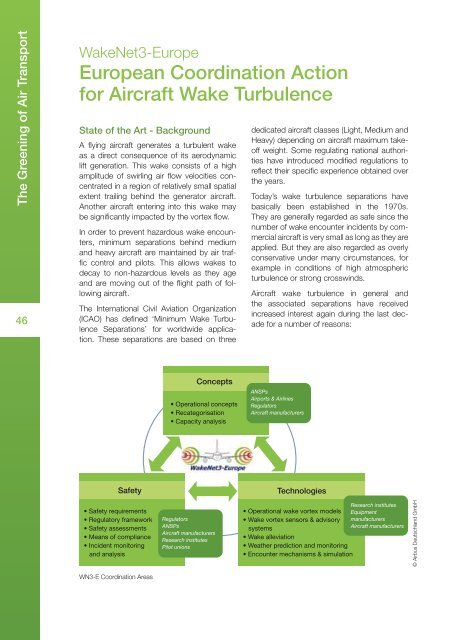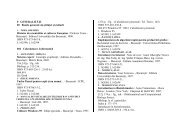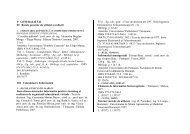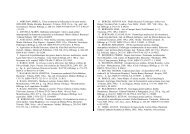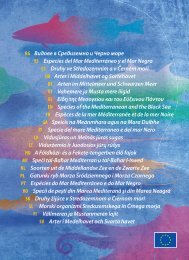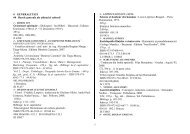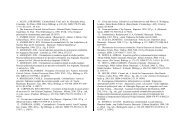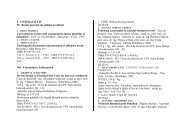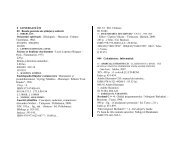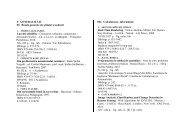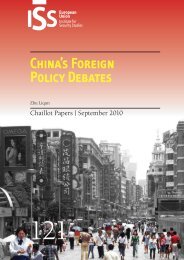- Page 1 and 2: EUROPEAN COMMISSION European Resear
- Page 3 and 4: EUROPEAN COMMISSION Aeronautics and
- Page 5: Greetings from the Commissioner for
- Page 9 and 10: Table of contents Introduction 9 In
- Page 11 and 12: European Aeronautics and Air Transp
- Page 13 and 14: Air Transport theme (AAT) is part o
- Page 15 and 16: Main research areas Under FP7, the
- Page 17 and 18: mental Compatible Air Transport Sys
- Page 19 and 20: Small and medium-sized enterprises
- Page 21: SESAR - Single European Sky Air Tra
- Page 24 and 25: Index by Activities 22 Increasing T
- Page 26 and 27: Index by Activities Pioneering the
- Page 28 and 29: Index by Technical Fields iSPACE in
- Page 30 and 31: Index by Technical Fields Breakthro
- Page 33 and 34: ATAAC Advanced Turbulence Simulatio
- Page 35 and 36: Acronym: ATAAC Name of proposal: Ad
- Page 37 and 38: objectives here are to enhance the
- Page 39 and 40: REACT4C Reducing Emissions from Avi
- Page 41 and 42: Acronym: REACT4C Name of proposal:
- Page 43 and 44: Description of Work The most essent
- Page 45 and 46: GreenAir Generation of Hydrogen by
- Page 47: Acronym: GreenAir Name of proposal:
- Page 51 and 52: AAS Integrated Airport Apron Safety
- Page 53 and 54: Acronym: AAS Name of proposal: Inte
- Page 55 and 56: Whole Engine Architecture Specifi c
- Page 57 and 58: Offi ce National d’Études et de
- Page 59 and 60: Key factors Engine upgrade/ Lube sy
- Page 61 and 62: ERICKA Engine Representative Intern
- Page 63 and 64: WP4 U-bend and radial passage: WP4
- Page 65 and 66: FUTURE Flutter-Free Turbomachinery
- Page 67 and 68: EU contribution: 6 996 196 € Call
- Page 69 and 70: State of the art of methodologies a
- Page 71 and 72: TECC-AE Technology Enhancements for
- Page 73 and 74: Acronym: TECC-AE Name of proposal:
- Page 75 and 76: Publication Dissemination COSMA wor
- Page 77 and 78: © German Aerospace Center FLOCON A
- Page 79 and 80: Acronym: FLOCON Name of proposal: A
- Page 81 and 82: Expected Results OPENAIR will devel
- Page 83 and 84: Short Brothers plc Snecma Propulsio
- Page 85 and 86: - Discriminate the origin of the so
- Page 87 and 88: © SILENCE(R) VALIANT VALidation an
- Page 89 and 90: Acronym: VALIANT Name of proposal:
- Page 91 and 92: © ACFA 2020 Consortium The Greenin
- Page 93 and 94: ALICIA All Condition Operations and
- Page 95 and 96: Acronym: ALICIA Name of proposal: A
- Page 97 and 98: ASSET Aeronautic Study on Seamless
- Page 99 and 100:
Acronym: ASSET Name of proposal: Ae
- Page 101 and 102:
- WP4: Development of the TITAN too
- Page 103 and 104:
ADDSAFE Advanced Fault Diagnosis fo
- Page 105 and 106:
WP4: ‘Industrial benchmarking ass
- Page 107 and 108:
- Assessing UV and IR temperature-m
- Page 109 and 110:
ulence protection equipment would h
- Page 111 and 112:
system which is optimised for the a
- Page 113 and 114:
HISVESTA High Stability Vertical Se
- Page 115 and 116:
Acronym: HISVESTA Name of proposal:
- Page 117 and 118:
Ensuring Customer Satisfaction and
- Page 119 and 120:
SCARLETT SCAlable and ReconfigurabL
- Page 121 and 122:
EC Officer: Mr. Hans Josef von den
- Page 123 and 124:
major simulation modules will be de
- Page 125 and 126:
iSPACE innovative Systems for Perso
- Page 127 and 128:
Acronym: iSPACE Name of proposal: i
- Page 129 and 130:
system in the cockpit, the aircraft
- Page 131 and 132:
ODICIS One DIsplay for a Cockpit In
- Page 133 and 134:
In parallel, a major point will be
- Page 135 and 136:
Objectives The global objective of
- Page 137 and 138:
PICASSO Improved Reliability Inspec
- Page 139 and 140:
Acronym: PICASSO Name of proposal:
- Page 141 and 142:
mal requirement languages such as R
- Page 143 and 144:
ALEF Aerodynamic Load Estimation at
- Page 145 and 146:
Acronym: ALEF Name of proposal: Aer
- Page 147 and 148:
iveting processes, complete functio
- Page 149 and 150:
© EADS Innovation Works Improving
- Page 151 and 152:
LAYSA Multifunctional Layers for Sa
- Page 153 and 154:
The integration of the three functi
- Page 155 and 156:
Regarding the ‘right fi rst time
- Page 157 and 158:
Fundación de la Ingeniera Civil de
- Page 159 and 160:
© CREAM / SAGEM Improving Cost Eff
- Page 161 and 162:
DAPHNE Developing Aircraft Photonic
- Page 163 and 164:
Acronym: DAPHNE Name of proposal: D
- Page 165 and 166:
APC Applications VoIP FTP HTTP …
- Page 167 and 168:
Monitor-soft Stichting Nationaal Lu
- Page 169 and 170:
Expected Results The TAUPE results
- Page 171 and 172:
ACCENT Adaptive Control of Manufact
- Page 173 and 174:
Acronym: ACCENT Name of proposal: A
- Page 175 and 176:
Comparison between broaching and Wi
- Page 177 and 178:
COALESCE2 Cost Efficient Advanced L
- Page 179 and 180:
Acronym: COALESCE2 Name of proposal
- Page 181 and 182:
development phase, to allow faster
- Page 183 and 184:
Associazione Esoce Net AVIO S.p.A.
- Page 185 and 186:
EXTICE EXTreme ICing Environment St
- Page 187 and 188:
Acronym: EXTICE Name of proposal: E
- Page 189 and 190:
LOAD FACTOR 3g 2g 1g 0g Vs1g VF A C
- Page 191 and 192:
FLEXA Advanced Flexible Automation
- Page 193 and 194:
Acronym: FLEXA Name of proposal: Ad
- Page 195 and 196:
ments respectively. There is some i
- Page 197 and 198:
glFEM Generic Linking of Finite Ele
- Page 199 and 200:
Acronym: glFEM Name of proposal: Ge
- Page 201 and 202:
all partners. Using the transducer,
- Page 203 and 204:
FANTOM Full-Field Advanced Non-Dest
- Page 205 and 206:
Acronym: FANTOM Name of proposal: F
- Page 207 and 208:
composite repairs and adapted to CN
- Page 209 and 210:
TRIADE Development of Technology Bu
- Page 211 and 212:
atteries, remote sensors implemente
- Page 213 and 214:
FLY-BAG Blastworthy Textile-Based L
- Page 215 and 216:
Expected Results Acronym: FLY-BAG N
- Page 217 and 218:
© Alenia Aeronautica Protection of
- Page 219 and 220:
Dassault Aviation SA University of
- Page 221 and 222:
Block 2: Application Development. -
- Page 223 and 224:
ATOM Airport detection and Tracking
- Page 225:
Acronym: ATOM Name of proposal: Air
- Page 228 and 229:
Pioneering the Air Transport of the
- Page 230 and 231:
Pioneering the Air Transport of the
- Page 232 and 233:
Pioneering the Air Transport of the
- Page 234 and 235:
Pioneering the Air Transport of the
- Page 236 and 237:
Pioneering the Air Transport of the
- Page 238 and 239:
Pioneering the Air Transport of the
- Page 240 and 241:
Pioneering the Air Transport of the
- Page 242 and 243:
Pioneering the Air Transport of the
- Page 245 and 246:
AEROCHINA2 Prospecting and Promotin
- Page 247 and 248:
Acronym: AEROCHINA2 Name of proposa
- Page 249 and 250:
WP4 support is given to turn a SME
- Page 251 and 252:
CEARES Central European Aeronautica
- Page 253 and 254:
Acronym: CEARES Name of proposal: C
- Page 255 and 256:
- assessing ideas; - the Internet-b
- Page 257 and 258:
EUROTURBO 8 Support to Eighth Europ
- Page 259 and 260:
Acronym: EUROTURBO 8 Name of propos
- Page 261 and 262:
The conference sessions are the fol
- Page 263 and 264:
- a website will be developed where
- Page 265 and 266:
Workshops will be held to discuss t
- Page 267 and 268:
AirTN-FP7 Air Transport Net (AirTN)
- Page 269 and 270:
Acronym: AirTN-FP7 Name of proposal
- Page 271 and 272:
WP3 aims to fi nd and analyse the m
- Page 273 and 274:
E-CAERO European Collaborative Diss
- Page 275 and 276:
Acronym: E-CAERO Name of proposal:
- Page 277 and 278:
stakeholders will be invited. Besid
- Page 279 and 280:
MONITOR Monitoring System of the De
- Page 281 and 282:
an effective use of the scenario te
- Page 283 and 284:
Children experimenting with fl ow v
- Page 285 and 286:
Index by Acronyms Acronym Project n
- Page 287 and 288:
Acronym Project name Grant Agreemen
- Page 289 and 290:
Index by Instruments CP - FP AAS In
- Page 291 and 292:
PPlane REACT4C Personal Plane: Asse
- Page 293 and 294:
Index by Partners 01dB-Metravib SAS
- Page 295 and 296:
APSYS SA 138 Aries Complex 149 ARIO
- Page 297 and 298:
Centre of Excellence in Aeronautica
- Page 299 and 300:
DLR - Deutsches Zentrum für Luft-
- Page 301 and 302:
Fischer Advanced Composite Componen
- Page 303 and 304:
INECO - Ingeniería y Economía del
- Page 305 and 306:
JRC - Commission of the European Co
- Page 307 and 308:
NATS En-Route Plc. 46 Naturen Indus
- Page 309 and 310:
ROSA 265 Rotech Engineering Ltd 156
- Page 311 and 312:
Swedish Defence Research Agency 40,
- Page 313 and 314:
UAC - United Aircraft Corporation 1
- Page 315 and 316:
University of Pisa - Department of
- Page 317 and 318:
List of National Contact Points ALB
- Page 319 and 320:
DENMARK Ms. SLOTH Béatrice L. Euro
- Page 321 and 322:
ITALY Ms. TEGAS Valentina APRE - Ag
- Page 323 and 324:
SERBIA Ms. MILOSEVIC Nada Ministry
- Page 325 and 326:
Directorate General for Research (R
- Page 327:
Sector Environmental Aspects of Aer
- Page 331 and 332:
How to obtain EU publications Publi


